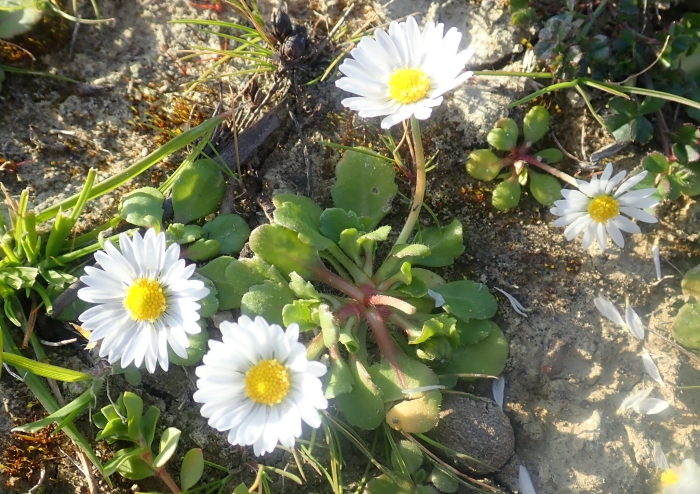Annual Daisy
(Bellis annua)
Annual Daisy (Bellis annua)
/
/

© Thomas Gyselinck
CC BY 4.0
Image By:
© Thomas Gyselinck
Recorded By:
Copyright:
CC BY 4.0
Copyright Notice:
Photo by: © Thomas Gyselinck | License Type: CC BY 4.0 | License URL: http://creativecommons.org/licenses/by/4.0/ | Uploader: thomas-- | Publisher: iNaturalist |






















Estimated Native Range
Summary
Bellis annua, commonly known as annual daisy, is an annual herb native to Europe and the Mediterranean regions, extending eastward to Iran, where it thrives in open grasslands, meadows, and disturbed sites. It is a diminutive plant, typically reaching up to 2 inches in height, with a basal rosette of small, often distinctly-toothed leaves. The flower heads are modest in size, featuring white petals with yellow centers, blooming in spring and early summer. The seeds of Bellis annua are finely short-hairy, which aids in their dispersal.
The annual daisy is appreciated for its dainty appearance and is often used in rock gardens, as a ground cover, or for naturalizing areas where a low-maintenance carpet of flowers is desired. It is well-suited to container gardening and can also be used in borders or as an edging plant. Bellis annua prefers full sun to partial shade and requires well-drained soil. It is relatively drought-tolerant once established but will benefit from regular watering during prolonged dry periods. While it is not known for significant pest or disease issues, it can become invasive outside its native range, so caution is advised when planting it in non-native areas.CC BY-SA 4.0
The annual daisy is appreciated for its dainty appearance and is often used in rock gardens, as a ground cover, or for naturalizing areas where a low-maintenance carpet of flowers is desired. It is well-suited to container gardening and can also be used in borders or as an edging plant. Bellis annua prefers full sun to partial shade and requires well-drained soil. It is relatively drought-tolerant once established but will benefit from regular watering during prolonged dry periods. While it is not known for significant pest or disease issues, it can become invasive outside its native range, so caution is advised when planting it in non-native areas.CC BY-SA 4.0
Plant Description
- Plant Type: Herb
- Height: 0.1-0.5 feet
- Width: 0.1-0.3 feet
- Growth Rate: Moderate
- Flower Color: White, Yellow
- Flowering Season: Spring, Summer, Fall
- Leaf Retention:
Growth Requirements
- Sun: Full Sun, Part Shade
- Water: Medium
- Drainage: Medium, Fast
Common Uses
Bee Garden, Border Plant, Low Maintenance
Natural Habitat
native to Europe and the Mediterranean regions, extending eastward to Iran, where it thrives in open grasslands, meadows, and disturbed sites
Other Names
Common Names: English Daisy, Lawn Daisy
Scientific Names: , Bellis annua, Bellis annua f. annua, Bellis annua f. caerulea, Bellis annua f. pubescens, Bellis annua subsp. majoricensis, Bellis annua var. acutisquama, Bellis annua var. acutisquama, Bellis annua var. annua, Bellis annua var. dentata
GBIF Accepted Name: